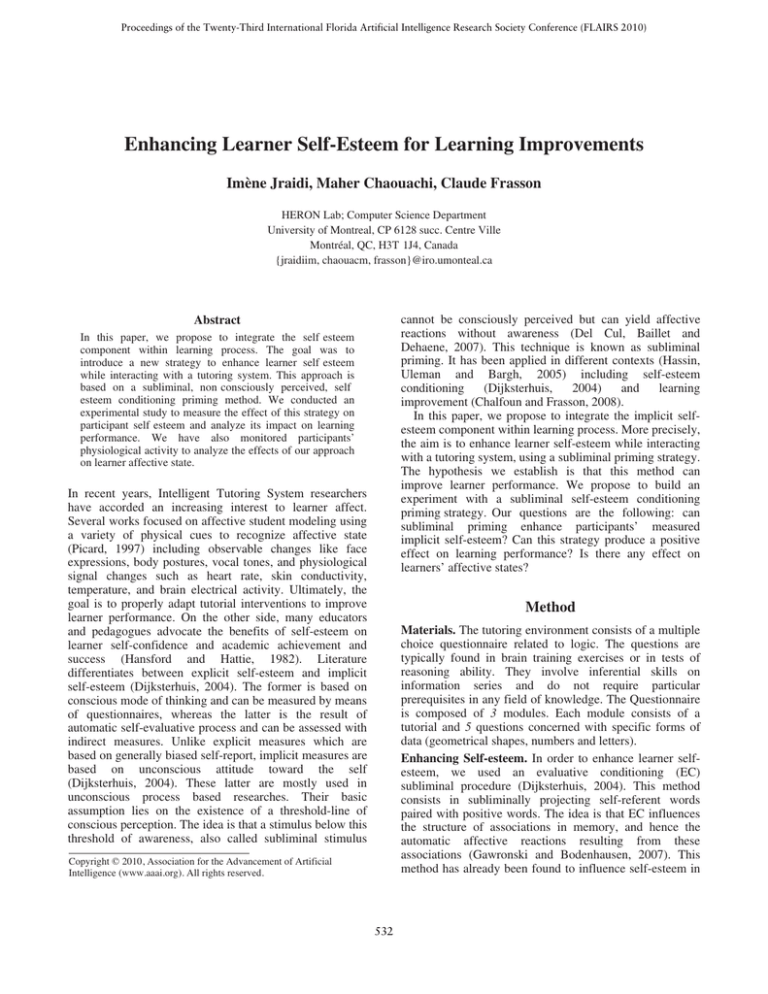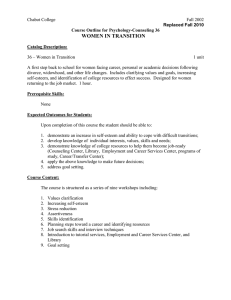
Proceedings of the Twenty-Third International Florida Artificial Intelligence Research Society Conference (FLAIRS 2010)
Enhancing Learner Self-Esteem for Learning Improvements
Imène Jraidi, Maher Chaouachi, Claude Frasson
HERON Lab; Computer Science Department
University of Montreal, CP 6128 succ. Centre Ville
Montréal, QC, H3T 1J4, Canada
{jraidiim, chaouacm, frasson}@iro.umonteal.ca
cannot be consciously perceived but can yield affective
reactions without awareness (Del Cul, Baillet and
Dehaene, 2007). This technique is known as subliminal
priming. It has been applied in different contexts (Hassin,
Uleman and Bargh, 2005) including self-esteem
conditioning
(Dijksterhuis,
2004)
and
learning
improvement (Chalfoun and Frasson, 2008).
In this paper, we propose to integrate the implicit selfesteem component within learning process. More precisely,
the aim is to enhance learner self-esteem while interacting
with a tutoring system, using a subliminal priming strategy.
The hypothesis we establish is that this method can
improve learner performance. We propose to build an
experiment with a subliminal self-esteem conditioning
priming strategy. Our questions are the following: can
subliminal priming enhance participants’ measured
implicit self-esteem? Can this strategy produce a positive
effect on learning performance? Is there any effect on
learners’ affective states?
Abstract
In this paper, we propose to integrate the self esteem
component within learning process. The goal was to
introduce a new strategy to enhance learner self esteem
while interacting with a tutoring system. This approach is
based on a subliminal, non consciously perceived, self
esteem conditioning priming method. We conducted an
experimental study to measure the effect of this strategy on
participant self esteem and analyze its impact on learning
performance. We have also monitored participants’
physiological activity to analyze the effects of our approach
on learner affective state.
In recent years, Intelligent Tutoring System researchers
have accorded an increasing interest to learner affect.
Several works focused on affective student modeling using
a variety of physical cues to recognize affective state
(Picard, 1997) including observable changes like face
expressions, body postures, vocal tones, and physiological
signal changes such as heart rate, skin conductivity,
temperature, and brain electrical activity. Ultimately, the
goal is to properly adapt tutorial interventions to improve
learner performance. On the other side, many educators
and pedagogues advocate the benefits of self-esteem on
learner self-confidence and academic achievement and
success (Hansford and Hattie, 1982). Literature
differentiates between explicit self-esteem and implicit
self-esteem (Dijksterhuis, 2004). The former is based on
conscious mode of thinking and can be measured by means
of questionnaires, whereas the latter is the result of
automatic self-evaluative process and can be assessed with
indirect measures. Unlike explicit measures which are
based on generally biased self-report, implicit measures are
based on unconscious attitude toward the self
(Dijksterhuis, 2004). These latter are mostly used in
unconscious process based researches. Their basic
assumption lies on the existence of a threshold-line of
conscious perception. The idea is that a stimulus below this
threshold of awareness, also called subliminal stimulus
Method
Materials. The tutoring environment consists of a multiple
choice questionnaire related to logic. The questions are
typically found in brain training exercises or in tests of
reasoning ability. They involve inferential skills on
information series and do not require particular
prerequisites in any field of knowledge. The Questionnaire
is composed of 3 modules. Each module consists of a
tutorial and 5 questions concerned with specific forms of
data (geometrical shapes, numbers and letters).
Enhancing Self-esteem. In order to enhance learner selfesteem, we used an evaluative conditioning (EC)
subliminal procedure (Dijksterhuis, 2004). This method
consists in subliminally projecting self-referent words
paired with positive words. The idea is that EC influences
the structure of associations in memory, and hence the
automatic affective reactions resulting from these
associations (Gawronski and Bodenhausen, 2007). This
method has already been found to influence self-esteem in
Copyright © 2010, Association for the Advancement of Artificial
Intelligence (www.aaai.org). All rights reserved.
532
earlier experiments (Dijksterhuis, 2004). In our
experiment, some participants (experimental condition),
were repeatedly projected with subliminal primes. The
other participants (control condition), were not presented
with subliminal primes. Projecting thresholds were
carefully chosen according to neural recommendations
(Del Cul, Baillet and Dehaene, 2007). Each subliminal
prime was displayed for 29 ms preceded and followed by a
271 ms mask of a set of sharp symbols.
Affect Recognition. Physiological signals were recorded
continuously during the experiment to monitor learners’
mental and emotional activities. We used three types of
sensors: electroencephalograms (EEG), skin conductance
(SC) and blood volume pulse (BVP) sensors. Heart rates
(HR) and galvanic skin response (GSR) were derived from
BVP and SC. These measures are known to be correlated
to valence (positive to negative) and arousal (low to high)
(Lang, 1995). In order to analyze participants’ mental state,
we used EEG signals. Neural research established various
EEG-based neural indexes of cognition. More precisely,
literature on attention and vigilance defined an EEG mental
engagement index (Pope, Bogart and Bartolome, 1995).
Higher index value reflects higher task engagement and
alertness. We used this index as an indication of the
participants’ mental engagement while answering to the
questionnaire.
Participants. 39 participants ranged in age from 19 to 47
years (M = 27.34, SD = 6.78) took part to our study in
return for a compensation of 10 CAD. They were assigned
either to the experimental condition (13 males, 7 females)
or to the control condition (11 males, 8 females).
(M = .71, SD = .09). F(1, 583) = 16.23, p < .001. Besides,
a significant main effect was found for GSR signals, F(1,
583) = 33.98, p < .05. Participants under the experimental
condition reported higher GSR values and hence higher
arousal (M = 1.26, SD = 4.42) than participants under the
control condition (M = -.91, SD = 3.93). The main effect
was not significant for HR, F(1, 583) = .64, p = n.s.
Conclusion
In this paper, we have proposed a new strategy to enhance
learner self-esteem while interacting with a tutoring
system. This approach is based on a subliminal, nonconsciously perceived, self-esteem conditioning method.
Our experimental study has shown that this method
enhanced participants’ measured implicit self-esteem on
one hand and learning performance on the other hand. On
the other side, priming conditions elicited different mental
and emotional reactions in terms of task engagement and
arousal. We believe that these findings can yield
interesting implications in intelligent tutoring systems.
Future works is directed towards learners’ self-esteem
modeling in order to extend ITS learner’s module.
Acknowledgments
We are grateful to the CRSNG (Conseil de Recherches en
Sciences Naturelles et en Génie du Canada) and the
Tunisian Government for their support.
References
Results
Chalfoun, P., and Frasson, C. 2008. Subliminal priming enhances learning
Self-esteem. Learner self-esteem was assessed using the
Initial Preference Task (IPT, (LeBel and Gawronski,
2009)). Participants were asked to evaluate their
attractiveness for all letters of the alphabet on a 7-point
scale. High self-esteem is indexed by the extent to which a
person prefers his or her initials to other letters of the
alphabet. It was found that IPT effect was more
pronounced for participants in the conditioned self-esteem
group (M = 1.68, SD = 0.94) compared to participants in
the control condition (M = 1.08, SD = 0.99) indicating
higher self-esteem. This difference was statistically
reliable, F(1, 37) = 4.84, p < .05.
Performance. In order to assess learner performance we
evaluated marks obtained in the questionnaire. Each
correct answer was worth 4 points, an incorrect answer -1,
and a no answer 0. Final marks were significantly higher in
the experimental condition (M = 33.4, SD = 12.36)
compared to those in the control condition (M= 25.5, SD =
9.87), F(1, 37) = 4.37, p < .05.
Learners’ affect. A main effect of priming conditions was
found for participant mental engagement: subliminally
primed participants reported higher engagement index
values (M = .75, SD = 0.11) than no primed participants
in a distant virtual 3D Intelligent Tutoring System. IEEE M.. 3: 125 130.
Del Cul, A., Baillet, S., and Dehaene, S. 2007. Brain dynamics underlying
the nonlinear threshold for access to consciousness. PLS, B. 5: 2408 2423.
Dijksterhuis, A. P. 2004. I like myself but I don’t know why: Enhancing
implicit self esteem by subliminal evaluative conditioning. JPSP 86.
Gawronski, B., and Bodenhausen, G. V. 2007. Unraveling the processes
underlying evaluation: Attitudes from the perspective of the APE Model.
Social Cogniton: 25: 687 717.
Hansford, B. C., and Hattie, J. A. 1982. The Relationship between self
and achievement/performance measures. RER 52: 123 142.
Hassin, R., Uleman, J., and Bargh, J. 2005. The new unconscious. Oxford,
UK: Oxford University Press.
Lang, P. J. 1995. The emotion probe: Studies of motivation and attention.
American Psychologist 50: 372 385.
LeBel, E. P., and Gawronski, B. 2009. How to find what's in a name:
Scrutinizing the optimality of five scoring algorithms for the name letter
task. Biological Psychology 23: 85 106.
Picard, R. 1997. Affective Computing: MIT Press.
Pope, A. T., Bogart, E. H., and Bartolome, D. S. 1995. Biocybernetic
system evaluates indices of operator engagement in automated task.
Biological Psychology 40: 187 195.
533






